8种基本时态及其被动结构
英语中8种时态的主动语态和被动语态
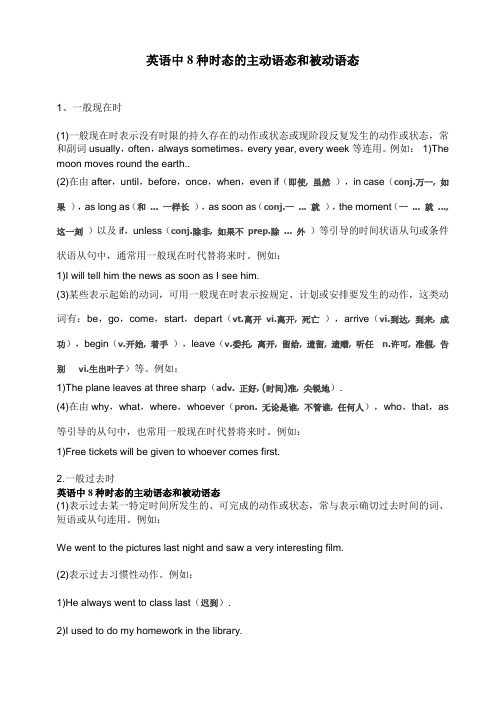
英语中8种时态的主动语态和被动语态1、一般现在时(1)一般现在时表示没有时限的持久存在的动作或状态或现阶段反复发生的动作或状态,常和副词usually,often,always sometimes,every year, every week等连用。
例如:1)The moon moves round the earth..(2)在由after,until,before,once,when,even if(即使, 虽然),in case(conj.万一, 如果),as long as(和 ... 一样长),as soon as(conj.一 ... 就),the moment(一 ... 就 ..., 这一刻)以及if,unless(conj.除非, 如果不prep.除 ... 外)等引导的时间状语从句或条件状语从句中,通常用一般现在时代替将来时。
例如:1)I will tell him the news as soon as I see him.(3)某些表示起始的动词,可用一般现在时表示按规定、计划或安排要发生的动作,这类动词有:be,go,come,start,depart(vt.离开vi.离开, 死亡),arrive(vi.到达, 到来, 成功),begin(v.开始, 着手),leave(v.委托, 离开, 留给, 遗留, 遗赠, 听任n.许可, 准假, 告别vi.生出叶子)等。
例如:1)The plane leaves at three sharp(adv. 正好, (时间)准, 尖锐地).(4)在由why,what,where,whoever(pron. 无论是谁, 不管谁, 任何人),who,that,as 等引导的从句中,也常用一般现在时代替将来时。
例如:1)Free tickets will be given to whoever comes first.2.一般过去时英语中8种时态的主动语态和被动语态(1)表示过去某一特定时间所发生的、可完成的动作或状态,常与表示确切过去时间的词、短语或从句连用。
(完整word版)八种时态主动语态被动语态

八种时态主动语态被动语态一般现在时(经常,反复,爱好,特点,条件,真理) do; does am;is;are done一般过去时(过去发生的事,不强调现在的结果) did; -ed was;were done一般将来时(将要发生的事) will do will be done现在进行时(现在正在发生的事) am;is;are doing am;is;are being done过去进行时(当时正在发生的事) was;were doing was;were being done现在完成时(过去发生的事,强调现在的结果) have;has done have;has been done过去完成时(过去完成的事;过去以前发生的事) had done had been done过去将来时(过去将要发生的事) would do would be done八种时态:• He is always ready to help others. 一般现在时• She often came to help us in those days.一般过去式• He is doing his homework now. 现在进行时• At that time she was doing her homework.过去进行时• I've written an article.现在完成时• By the end of last month. We had reviewed four books 。
过去完成时• It is going to rain.一般将来时• I asked who was going there. 过去将来时一般现在时1.概念:经常、反复发生的动作或行为及现在的某种状况。
2.时间状语:always, usually, often, sometimes, every week (day, year, month…), once a week, on Sundays,3.基本结构:动词原形(如主语为第三人称单数,动词上要改为第三人称单数形式)4.否定形式:am/is/are+not;此时态的谓语动词若为行为动词,则在其前加don't,如主语为第三人称单数,则用doesn't,同时还原行为动词。
英语八大基本时态及其对应被动语态

过去将来时 2. was/were+ going to do
2. was/were+ going to be+过去分词
句型转换
• • • • • • • • • • All his students love him. He is loved by all his students. My aunt brought me up. I was brought up by my aunt. We will hold an examination next week. An examination will be held next week. We are going to discuss this problem tomorrow. This problem is going to be discussed tomorrow. We have finished this task. This task have been finished.
时态
主动语态
被动语态
一般现在时
一般过去时
1. am/is/are 2. 动词原形 1. was/were 2. 动词过去式
am/is/are + 过去分词 was/were + 过去分词
现在进行时 过去进行时
am/is/are + am/is/are + doing being+过去分词 was/were + was/were + doing being&• • • • • • 学校图书馆正在建设中。 The school library is being built now. 那座图书馆去年五月的时候正在建设中。 That library was being built last May. 我们来之前已经有人闯入这个屋子了。 This room had been broken into before we came.
八大时态的被动语态结构

八大时态的被动语态结构
以下是八大时态的被动语态结构:
1. 现在时被动语态(Present Simple Passive):主语 + am/is/are + 过去分词。
2. 过去时被动语态(Past Simple Passive):主语 + was/were + 过去分词。
3. 将来时被动语态(Future Simple Passive):主语+ will be + 过去分词。
4. 现在进行时被动语态(Present Continuous Passive):主语 + am/is/are being + 过去分词。
5. 过去进行时被动语态(Past Continuous Passive):
主语 + was/were being + 过去分词。
6. 现在完成时被动语态(Present Perfect Passive):
主语 + has/have been + 过去分词。
7. 过去完成时被动语态(Past Perfect Passive):主语 + had been + 过去分词。
8. 将来完成时被动语态(Future Perfect Passive):主语 + will have been + 过去分词。
英语八大时态总结表8种基本时态结构句型
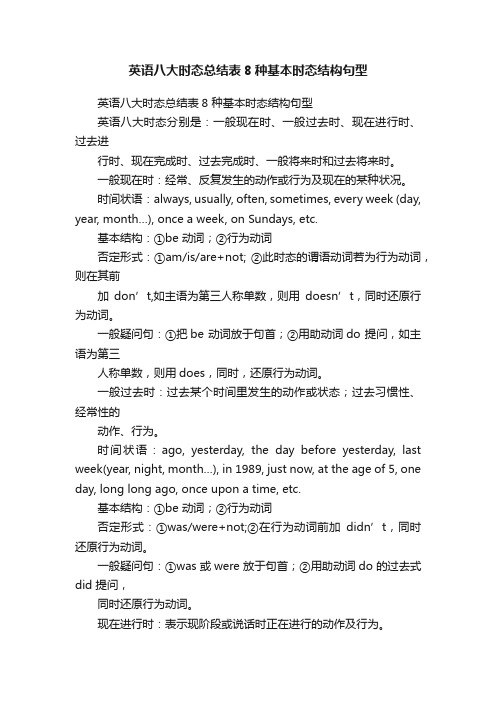
英语八大时态总结表8种基本时态结构句型英语八大时态总结表8 种基本时态结构句型英语八大时态分别是:一般现在时、一般过去时、现在进行时、过去进行时、现在完成时、过去完成时、一般将来时和过去将来时。
一般现在时:经常、反复发生的动作或行为及现在的某种状况。
时间状语:always, usually, often, sometimes, every week (day, year, month…), once a week, on Sundays, etc.基本结构:①be 动词;②行为动词否定形式:①am/is/are+not; ②此时态的谓语动词若为行为动词,则在其前加don’t,如主语为第三人称单数,则用doesn’t,同时还原行为动词。
一般疑问句:①把be 动词放于句首;②用助动词do 提问,如主语为第三人称单数,则用does,同时,还原行为动词。
一般过去时:过去某个时间里发生的动作或状态;过去习惯性、经常性的动作、行为。
时间状语:ago, yesterday, the day before yesterday, last week(year, night, month…), in 1989, just now, at the age of 5, one day, long long ago, once upon a time, etc.基本结构:①be 动词;②行为动词否定形式:①was/were+not;②在行为动词前加didn’t,同时还原行为动词。
一般疑问句:①was 或were 放于句首;②用助动词do 的过去式did 提问,同时还原行为动词。
现在进行时:表示现阶段或说话时正在进行的动作及行为。
时间状语:now, at this time, these days, etc.。
英语的八种时态的结构

英语的八种基本时态包括:一般现在时、一般过去时、一般将来时、过去将来时、现在进行时、过去进行时、现在完成时和过去完成时。
以下是这八种时态的基本结构和用法:1.一般现在时:1.结构:主语+ 动词原形/第三人称单数形式(动词+s/es)+ 其他。
2.用法:描述经常发生的动作或状态,表达普遍真理或习惯性行为。
2.一般过去时:1.结构:主语+ 动词过去式+ 其他。
2.用法:描述过去某个时间发生的动作或状态。
3.一般将来时:1.结构:主语+ will/shall + 动词原形+ 其他;主语+ be going to +动词原形+ 其他;主语+ be to + 动词原形+ 其他;主语+ be about to + 动词原形+ 其他;主语+ be due to + 动词原形+ 其他;主语+ be on the point of + 动名词形式+ 其他。
2.用法:描述将来某个时间将要发生的动作或状态。
4.过去将来时:1.结构:主语+ would/should + 动词原形+ 其他。
2.用法:描述过去某个时间将来要发生的动作或状态。
5.现在进行时:1.结构:主语+ be 动词(am/is/are)+ 现在分词(动词+ing)+ 其他。
2.用法:描述正在进行的动作或状态。
6.过去进行时:1.结构:主语+ be 动词的过去式(was/were)+ 现在分词(动词+ing)+ 其他。
2.用法:描述过去某个时间点正在进行的动作或状态。
7.现在完成时:1.结构:主语+ have/has + 过去分词(动词+ed)+ 其他。
2.用法:描述过去发生的动作对现在造成的影响或结果,或者表示从过去某一时间开始一直持续到现在的情况。
8.过去完成时:1.结构:主语+ had + 过去分词(动词+ed)+ 其他。
2.用法:描述过去某个时间点之前已经完成的动作或状态,或者表示一个过去的动作在另一个过去的动作之前发生。
请注意,以上列出的时态结构和用法是基本的概述,实际使用中可能因语境和习惯而有所不同。
英语八种时态讲解
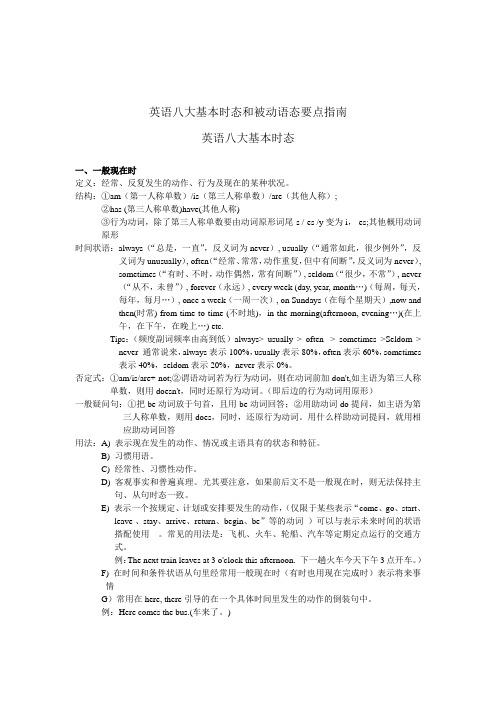
英语八大基本时态和被动语态要点指南英语八大基本时态一、一般现在时定义:经常、反复发生的动作、行为及现在的某种状况。
结构:①am(第一人称单数)/is(第三人称单数)/are(其他人称);②has (第三人称单数)have(其他人称)③行为动词,除了第三人称单数要由动词原形词尾-s /-es /y变为i,-es;其他概用动词原形时间状语:always(“总是,一直”,反义词为never), usually(“通常如此,很少例外”,反义词为unusually), often(“经常、常常,动作重复,但中有间断”,反义词为never),sometimes(“有时、不时,动作偶然,常有间断”), seldom(“很少,不常”), never(“从不,未曾”), forever(永远), every week (day, year, month…)(每周,每天,每年,每月…), once a week(一周一次), on Sundays(在每个星期天),now andthen(时常) from time to time (不时地),in the morning(afternoon, evening…)(在上午,在下午,在晚上…) etc.Tips:(频度副词频率由高到低)always> usually > often > sometimes >Seldom >never 通常说来,always表示100%,usually表示80%,often表示60%,sometimes表示40%,seldom表示20%,never表示0%。
否定式:①am/is/are+ not;②谓语动词若为行为动词,则在动词前加don't,如主语为第三人称单数,则用doesn't,同时还原行为动词。
(即后边的行为动词用原形)一般疑问句:①把be动词放于句首,且用be动词回答;②用助动词do提问,如主语为第三人称单数,则用does,同时,还原行为动词。
八种时态的结构和被动语态

八种时态的结构和被动语态一、一般现在时态一般现在时态表示经常性的动作或状态。
在句子中,主语加上动词的原形即可构成一般现在时态的句子。
例句:Dogs bark.(狗叫。
)被动语态:由“be+过去分词”构成。
例句:The cake is baked by my mother.(蛋糕是我妈妈烤的。
)二、一般过去时态一般过去时态表示过去某个时间发生的动作或存在的状态。
在句子中,主语加上动词的过去式即可构成一般过去时态的句子。
例句:She ate an apple yesterday.(她昨天吃了一个苹果。
)被动语态:由“was/were+过去分词”构成。
例句:The book was written by Mark Twain.(这本书是马克·吐温写的。
)三、一般将来时态一般将来时态表示将要发生的动作或存在的状态。
在句子中,主语加上助动词“will”或“shall”,再加上动词的原形即可构成一般将来时态的句子。
例句:I will visit my grandparents next week.(我下周会去看望我的祖父母。
)被动语态:由“wil l be+过去分词”或“is/am/are going to be+过去分词”构成。
例句:The letter will be delivered by the postman.(这封信将由邮递员投递。
)四、现在进行时态现在进行时态表示现在正在进行的动作。
在句子中,主语加上“be”动词的现在分词形式,再加上动词的原形即可构成现在进行时态的句子。
例句:She is watching TV now.(她正在看电视。
)被动语态:由“am/is/are being+过去分词”构成。
例句:The house is being cleaned by the maid.(房子正在被女仆打扫。
)五、过去进行时态过去进行时态表示过去某个时间正在进行的动作。
在句子中,主语加上“was/were”动词的现在分词形式,再加上动词的原形即可构成过去进行时态的句子。
各种时态的被动语态

各种时态的被动语态一、八大时态的被动语态的构成:1.一般现在时的被动语态构成:(am/is/are +done)如:I am asked to study hard. 我被请求努力学习。
This shirt is washed once a week. 这件T恤一周洗一次。
These songs are usually sung by boys. 这些歌曲通常是男生唱的。
2.一般过去时的被动语态构成:(was/were done)如:The soldier was killed, but the train was saved. 这位战士牺牲了,然而列车得救了。
Some notes were passed up to the speaker. 有人给讲演者递上来一些纸条。
3.一般将来时的被动语态构成:(shall/will be done)如:We shall be asked a lot of strange questions. 我们将被问许多怪题。
My son will be sent to school next September. 来年九月我将送我儿子去读书。
4.过去将来时的被动语态构成:(should/would be done)如:The news would be sent to him as soon as it arrived. 消息一到就会转给他的。
He told us that the new railway would be built the next year. 他告诉我新铁路将在明年修建。
5.现在完成时的被动语态构成:(has/have been done)如:The work has just been finished. 工作刚刚结束。
The old rules have been done away with by us. 旧规章已经被我们废除了。
6.过去完成时的被动语态构成:(had been done)如:By last December three ships had been built by them. 到去年十二月底他们已建造了三艘船。
英语八种时态基本句型及其被动

英语八种时态基本句型,及其被动一般现在时1.概念:指经常、反复发生的动作或行为及现在的某种状况。
2.时间状语:always, usually, often, sometimes, every week (day, year, month), once a week, on Sundays,3.基本结构:动词+ 原形(如主语为第三人称单数,动词上要加(e)S)4.否定形式:am/is/are+not;此时态的谓语动词若为行为动词,则在其前加don't,如主语为第三人称单数,则用doesn't,同时还原行为动词。
5.一般疑问句:把be动词放于句首;用助动词do提问,如主语为第三人称单数,则用does,同时,还原行为动词。
6.例句:. It seldom snows here.He is always ready to help others.Action speaks louder than words.7.特殊用法:一些动词可用一般现在时来表达现在进行时:verbs of the senses: hear,see,taste,smellverbs of the thinking: believe,know,mean,realize,think,rememberverbs of the linking: dislike,fear,hate,like,love,wantverbs of the possession: belong,have,own,possess一般过去时1.概念:过去某个时间里发生的动作或状态;过去习惯性、经常性的动作、行为。
2.时间状语:ago, yesterday, the day before yesterday, last week(year, night, month), just now, at the age of 5, one day, long long ago, once upon a time, etc.3.基本结构:含有Be动词主语+was/were+......不含有be动词:主语+动词过去式+......4.否定句:带be:主语+was/were not+动词原形+......不带be:主语+didn't+动词原形+......5.一般疑问句:含be动词was或were放于句首;不含be动词用助动词do的过去式did 提问,同时还原行为动词原型。
英语八大时态总结表 8种基本时态结构句型
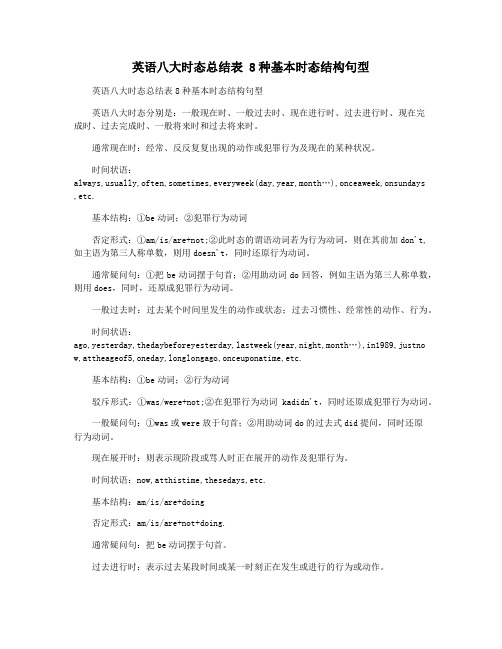
英语八大时态总结表 8种基本时态结构句型英语八大时态总结表8种基本时态结构句型英语八大时态分别是:一般现在时、一般过去时、现在进行时、过去进行时、现在完成时、过去完成时、一般将来时和过去将来时。
通常现在时:经常、反反复复出现的动作或犯罪行为及现在的某种状况。
时间状语:always,usually,often,sometimes,everyweek(day,year,month…),onceaweek,onsundays,etc.基本结构:①be动词;②犯罪行为动词否定形式:①am/is/are+not;②此时态的谓语动词若为行为动词,则在其前加don't,如主语为第三人称单数,则用doesn't,同时还原行为动词。
通常疑问句:①把be动词摆于句首;②用助动词do回答,例如主语为第三人称单数,则用does,同时,还原成犯罪行为动词。
一般过去时:过去某个时间里发生的动作或状态;过去习惯性、经常性的动作、行为。
时间状语:ago,yesterday,thedaybeforeyesterday,lastweek(year,night,month…),in1989,justno w,attheageof5,oneday,longlongago,onceuponatime,etc.基本结构:①be动词;②行为动词驳斥形式:①was/were+not;②在犯罪行为动词kadidn't,同时还原成犯罪行为动词。
一般疑问句:①was或were放于句首;②用助动词do的过去式did提问,同时还原行为动词。
现在展开时:则表示现阶段或骂人时正在展开的动作及犯罪行为。
时间状语:now,atthistime,thesedays,etc.基本结构:am/is/are+doing否定形式:am/is/are+not+doing.通常疑问句:把be动词摆于句首。
过去进行时:表示过去某段时间或某一时刻正在发生或进行的行为或动作。
各种时态的被动语态

各种时态的被动语态各种时态的被动语态一、八大时态的被动语态的构成:1.一般现在时的被动语态构成:(am/is/are +done)如:I am asked to study hard. 我被请求努力学习。
This shirt is washed once a week. 这件T恤一周洗一次。
These songs are usually sung by boys. 这些歌曲通常是男生唱的。
2.一般过去时的被动语态构成:(was/were done)如:The soldier was killed, but the train was saved. 这位战士牺牲了,然而列车得救了。
Some notes were passed up to the speaker. 有人给讲演者递上来一些纸条。
3.一般将来时的被动语态构成:(shall/will be done)如:We shall be asked a lot of strange questions. 我们将被问许多怪题。
My son will be sent to school next September. 来年九月我将送我儿子去读书。
4.过去将来时的被动语态构成:(should/would be done)如:The news would be sent to him as soon as it arrived. 消息一到就会转给他的。
He told us that the new railway would be built the next year. 他告诉我新铁路将在明年修建。
5.现在完成时的被动语态构成:(has/have been done)如:The work has just been finished. 工作刚刚结束。
The old rules have been done away with by us. 旧规章已经被我们废除了。
8种基本时态及其被动结构

英语8种基本时态英语中表示不同时间发生的动作或存在的状态,需用不同的动词形式表示,这种不同的动词形式称为时态。
二.种类和用法:1.一般现在时:表示现在或现阶段经常发生或习惯性的动作或状态及客观现实和普遍真理。
一般现在时常以动词原形表示,但当主语是第三人称单数时,动词词尾加—s或—es。
We go shopping once a week。
He goes to work by bike every day.The sun always rises in the east .The light travels faster than the sound .※一般现在时第三人称单数动词的变化形式。
a)一般情况动词在词尾加-s . come—--comes speak--—speaksb)以o,s,x, ch, sh结尾的单词在词后加—es。
do——-does pass——-passes watch---watchesc)以“辅音字母+y”结尾的单词变y为i加—es. study——-studies cry--—criesd)以“元音字母+y”结尾的单词直接加—s。
play-—-plays stay--—stays2.一般过去时:表示发生在过去的动作或存在的状态I was a student 6 years ago. I went to Beijing last year。
※动词过去式变化规则.a)一般情况下的词加—ed. work—-—worked call----calledb)以不发音的字母e结尾的单词直接加-d . live—-—-lived change-——-changedc)以“辅音字母+y”结尾的单词,变y为i加—ed。
study———-studied carry——--carriedd)以“元音字母+y”结尾的单词直接加-ed。
play--——played stay——--stayede) 以一个辅音字母结尾的重读闭音节的(x除外)动词,应先双写这个辅音字母然后再加—ed。
初中英语必考八大时态结构及用法详解
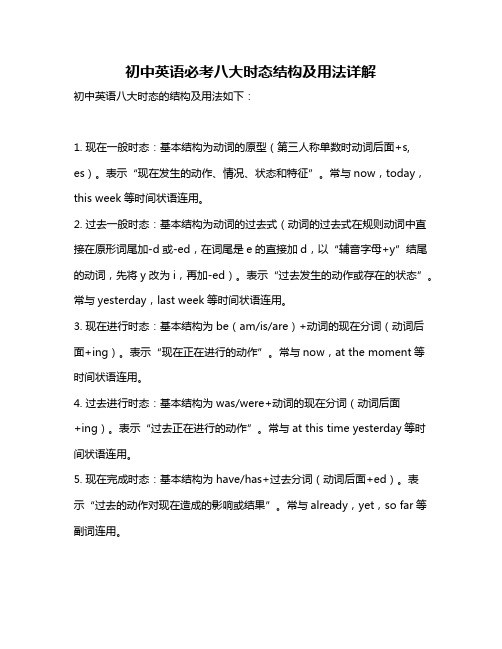
初中英语必考八大时态结构及用法详解初中英语八大时态的结构及用法如下:1. 现在一般时态:基本结构为动词的原型(第三人称单数时动词后面+s, es)。
表示“现在发生的动作、情况、状态和特征”。
常与now,today,this week等时间状语连用。
2. 过去一般时态:基本结构为动词的过去式(动词的过去式在规则动词中直接在原形词尾加-d或-ed,在词尾是e的直接加d,以“辅音字母+y”结尾的动词,先将y改为i,再加-ed)。
表示“过去发生的动作或存在的状态”。
常与yesterday,last week等时间状语连用。
3. 现在进行时态:基本结构为be(am/is/are)+动词的现在分词(动词后面+ing)。
表示“现在正在进行的动作”。
常与now,at the moment等时间状语连用。
4. 过去进行时态:基本结构为was/were+动词的现在分词(动词后面+ing)。
表示“过去正在进行的动作”。
常与at this time yesterday等时间状语连用。
5. 现在完成时态:基本结构为have/has+过去分词(动词后面+ed)。
表示“过去的动作对现在造成的影响或结果”。
常与already,yet,so far等副词连用。
6. 过去完成时态:基本结构为had+过去分词(动词后面+ed)。
表示“过去的动作在过去的某个时间之前已经完成或发生的动作或存在的状态”。
常与by the end of last year,by the time of等时间状语连用。
7. 现在完成进行时态:基本结构为have/has been+动词的现在分词(动词后面+ing)。
表示“动作从过去某时开始,一直延续到现在,或者刚刚完成”。
常与for several days,since等时间状语连用。
8. 过去完成进行时态:基本结构为had been+动词的现在分词(动词后面+ing)。
表示“过去的某个动作从过去某时开始,一直延续到过去的某个时间,或者刚刚完成”。
8种时态的被动语态

动词的语态:主动语态和被动语态被动语态的基本结构:Be + done(过去分词)1、一般现在时:(主动语态)I help you.发出者动词承受者变为被动语态:Do——am/is/are doneYou are helped by me.承受者谓语发出者2、一般过去时的被动:did——was/were done(I helped you.-每个例子可让学生自己先尝试变被动,再给答案)3、一般将来时的被动:Will do——will be done(I will help you.-)4、现在进行时的被动:Am/is/are doing ——Am/is/are being done(I am helping you.-)5、过去进行时的被动:Was/were doing——Was/were being done(I was helping you.-)6、现在完成时的被动:Have done——have been done (I have helped you.-)7、过去完成时的被动:Had done——had been done (I had helped you.-)8、过去将来时的被动:Would do ——would be done (I would help you.-)答案:2、You were helped by me.3、You will be helped by me.4、You are being helped by me.5、You were being helped by me.6、You have been helped by me.7、You had been helped by me.8、You would be helped by me.。
英语中各种时态的结构

英语中有八种基本时态,每种时态都有其特定的结构和用法。
以下是这些时态及其结构的简要概述:1. 一般现在时(Simple Present Tense)-结构:主语+ 动词原形(第三人称单数使用动词第三人称单数形式)-用途:描述经常性或习惯性的动作,或描述客观事实。
-例子:I eat an apple every day. (我每天吃一个苹果。
)2. 现在进行时(Present Continuous Tense)-结构:主语+ be 动词(am/is/are)+ 动词-ing-用途:描述正在进行的动作或情况。
-例子:I am studying right now. (我现在正在学习。
)3. 一般将来时(Simple Future Tense)-结构:主语+ will + 动词原形-用途:描述未来将要发生的动作或情况。
-例子:I will go to the park tomorrow. (我明天要去公园。
)4. 一般过去时(Simple Past Tense)-结构:主语+ 动词过去式-用途:描述过去发生的动作或情况。
-例子:I went to the museum last week. (我上周去了博物馆。
)5. 现在完成时(Present Perfect Tense)-结构:主语+ have/has + 动词过去分词-用途:描述过去发生的动作对现在造成的影响或结果。
-例子:I have finished my homework. (我已经完成了我的作业。
)6. 过去完成时(Past Perfect Tense)-结构:主语+ had + 动词过去分词-用途:描述过去某个时间之前已经完成的动作。
-例子:I had learned French before I went to France. (我去法国之前已经学了法语。
)7. 过去进行时(Past Continuous Tense)-结构:主语+ was/were + 动词-ing-用途:描述过去某个时间正在进行的动作。
英语必考八大时态结构及用法详解

英语必考八大时态结构及用法详解一、一般现在时1. 概念:经常、反复发生的动作或行为及现在的某种状况.2. 基本结构:①is/am/are;②do/does否定形式:①am/is/are+not;②此时态的谓语动词若为行为动词,则在其前加don't,如主语为第三人称单数,则用doesn't,同时还原行为动词.3。
一般疑问句:①把is/am/are动词放于句首;②用助动词do提问,如主语为第三人称单数,则用does,同时,还原行为动词.4。
用法1) 经常性或习惯性的动作,常与表示频度的时间状语连用.例如:I leave home for school at 7 every morning。
每天早上我七点离开家.2) 客观真理,客观存在,科学事实。
例如:The earth moves around the sun。
地球绕太阳转动.Shanghai lies in the east ofChina. 上海位于中国东部.3) 表示格言或警句。
例如:Pride goes before a fall. 骄者必败。
注意:此用法如果出现在宾语从句中,即使主句是过去时,从句谓语也要用一般现在时。
例如:Columbus proved that the earth is round. 哥伦布证实了地球是圆的.4) 现在时刻的状态、能力、性格、个性.例如:I don’t want so much。
我不要那么多.Ann writes good English but does not speak well.安英语写得不错,讲的可不行.5) 一般现在时表示将来含义a。
下列动词come,go, arrive, leave, start,begin, return的一般现在时可以表示将来,主要用来表示在时间上已确定或安排好的事情。
例如:The train leaves at six tomorrow morning。
英语八种时态讲解

英语八大基本时态和被动语态要点指南英语八大基本时态一、一般现在时定义:经常、反复发生的动作、行为及现在的某种状况..结构:①am第一人称单数/is第三人称单数/are其他人称;②has 第三人称单数have其他人称③行为动词;除了第三人称单数要由动词原形词尾-s /-es /y变为i;-es;其他概用动词原形时间状语:always“总是;一直”;反义词为never; usually“通常如此;很少例外”;反义词为unusually; often“经常、常常;动作重复;但中有间断”;反义词为never; sometimes“有时、不时;动作偶然;常有间断”; seldom“很少;不常”; never“从不;未曾”; forever永远; every week day; year; month…每周;每天;每年;每月…; once a week一周一次; on Sundays在每个星期天;now and then时常 from time to time 不时地;inthe morningafternoon; evening…在上午;在下午;在晚上…etc.Tips:频度副词频率由高到低always> usually > often >sometimes >Seldom > never 通常说来;always表示100%;usually表示80%;often表示60%;sometimes表示40%;seldom表示20%;never表示0%..否定式:①am/is/are+ not;②谓语动词若为行为动词;则在动词前加don't;如主语为第三人称单数;则用doesn't;同时还原行为动词..即后边的行为动词用原形一般疑问句:①把be动词放于句首;且用be动词回答;②用助动词do提问;如主语为第三人称单数;则用does;同时;还原行为动词..用什么样助动词提问;就用相应助动词回答用法:A 表示现在发生的动作、情况或主语具有的状态和特征..B 习惯用语..C 经常性、习惯性动作..D 客观事实和普遍真理..尤其要注意;如果前后文不是一般现在时;则无法保持主句、从句时态一致..E 表示一个按规定、计划或安排要发生的动作;仅限于某些表示“come、go、start、leave 、stay、arrive、return、begin、be”等的动词可以与表示未来时间的状语搭配使用 ..常见的用法是:飞机、火车、轮船、汽车等定期定点运行的交通方式..例:The next train leaves at 3 o'clock this afternoon. 下一趟火车今天下午3点开车..F 在时间和条件状语从句里经常用一般现在时有时也用现在完成时表示将来事情G常用在here; there引导的在一个具体时间里发生的动作的倒装句中..例:Here comes the bus.车来了..二. 一般过去时定义:过去的某个时间里发生的动作、状况;过去习惯性、经常性的动作、行为..结构:①was第一、第三人称单数/were其他人称;②have;一律用had;③行为动词一律用过去式..时间状语: ago以前; yesterday昨天; the day before yesterday前天;last weekyear; night; month…上周/去年/昨晚/上个月; in1989; just now刚才; a moment ago刚才;at the age of 6六岁时; one day某一天; long long ago很久以前; onceupon a time很久很久以前;曾经;从前 ;etc.否定式:①was/were+ not;②在行为动词前加didn't;同时还原行为动词.. 一般疑问句:①was或were放于句首;②用助动词do的过去式did提问;同时还原行为动词..用法: A 表示过去某个时间发生的动作或存在的状况..B 表示过去习惯性动作..特别是由would/ used to do表达的句型;本身表示的就是过去时..He used to visit his mother once a week.他以前总是每周看望一次他的母亲..Tips:used to do过去常常做;现在却不做了;只用于过去式..be used to doing习惯于做某事;可用于各种时态P62;8be used to do 被动语态;某物被用于做什么用途;可用于各种时态;但语态只用于被动语态三. 一般将来时概念:表示将要发生的动作或存在的状态及打算、计划或准备做某事.. 基本结构:①am/is/are/going to + do;②shall第一人称 /will其他人称+ do. ③、am/is/are/ to do ④am/is/are/goingabout to do⑤、一般现在时表将来⑥、现在进行时表将来..时间状语:tomorrow明天; next dayweek; month; year…第二天/下周/下个月/明年;soon很快; in a few minutes几分钟内; by…到…; the day after tomorrow后天; in future今后;从今以后;in the future将来;未来;some day将来某一天etc. 否定形式:①表达式中借助be动词的;在be加 not即可; ②will/shall+ not;缩写为won’t/shan’t一般疑问句:①be放于句首;②will/shall提到句首;用相应的助动词回答..用法: A will / shall do表达将来要发生的动作或将来经常反复发生的动作..例:We shall send her a glass hand-made craft as her birthday gift.B 有些动词;如:arrive; be close; come; do; done; go; have;leave; open; play; return; sleep; start; stay等;用于现在进行时;并且通常与一个表示将来时间的时间状语连用;可以表示将来时..例:My mother is coming to visit me next week and is stayinghere until May.我妈妈下周将来看我;并会呆到5月..C 表示“打算去……;要……”时;可用be going to do..例:This is just what I am going to say.这正是我想说的..D 表示“即将、正要”时;可用be about to do..强调近期内或马上要做的事.. 例:Don't worry; I am about to makea close examination on you.E "be to do" ①表示“按计划、安排即将发生某事或打算做某事”.. ②要求或命令某人去做的事或征求对方意见..F 同样可以表示“正要、将要”的意思的句型是be on the point of doing..例题: I was _______ the point of telephoning him when his letter arrived.A inB toC atD on 答案是D..on the pointof doing 是固定词组;意思是“正要、打算”..全句的意思是:“当他的信到的时候我正要打电话给他..”Tips:在以if; when; as long as; as soon as; after; before;in case; until; unless等连词以及具有连词作用的副词immediately; the moment; directly等引导的状语从句中;一般用现在时代替将来时..强调延续性或动态时;可用完成时..例:I hope his health will have improved by the time youcome back next year.我希望到明年你回来的时候;他的身体已经好多了..四、现在进行时概念:表示现阶段或说话时正在进行的动作及行为..基本结构:am/is/are+ doing时间状语:now; at this time现在; these days这些天; etc.否定形式:am/is/are+ not+ doing.一般疑问句:把be动词放于句首..用什么be动词提问就用相应be 动词回答..用法: A 表示说话时刻或现在的时间段内正在发生的动作或存在的状况..B进行时表示计划安排将要发生的动作仅限于某些表示“come、go、begin、start、leave 、stay、arrive、return、begin、be”等的动词..C副词always、 forever、 repeatedly屡次;frequently时常、经常等常和现在进行时连用;表经常性动作或状态;并带有赞许、厌恶等情感色彩..例:He is always helping others.称赞口吻Tips:并非所有动词都可用于进行时:表示知觉、感觉、愿望、看法、认识、感情和状态的词;不般可用于进行时..如:love;like; die; see; hear; have; be等;除非将其词义转换成一个表示正在进行的动作;才可用于进行时;例:What are youthinking about五、现在完成时定义:过去完成或已经发生的动作对现在造成的影响和结果;或者是从过去已经开始持续到现在的动作或状态..基本结构:have/has + done过去分词;规则和不规则变化时间状语:already已经;多用于肯定的陈述句;never从不;not…yet还没;ever曾经;yet已经;多用于否定句;just刚刚;before之前recently最近; lately近来; so far到目前为止;up till now至今;in recent years在最近几年里; since/for/by自从/长达/到 ; etc.否定形式:have/has + not +done.一般疑问句:have或has放于句首..用相应的助动词回答..用法: A 表示动作到现在为止已经完成或刚刚完成..B 过去所发生的某一动作对当前造成的影响或结果..C表示从过去某时刻开始;持续到现在的动作或情况;并且有可能会继续延续下去;重在强调“迄今已有多久”此时经常用延续性动词若为非延续性动词;则需要将其转化为延续性动词的表达形式..时间状语常用since加一个过去的时间点;或for加一段时间;或by加一个现在时间..Tips:①现在完成时是联系过去和现在的纽带..现在完成时和过去时的区别在于:现在完成时强调动作的动态;或受动态的影响;是动态的结果;总之是和现在有影响有联系的;过去时只表示过去的某个具体时间里发生的动作;与现在没有联系..②have been to 是“已经去过某地;现已经回来”;常和ever、never、once、twice、before连用.. 例:I'vebeen to China 我去过中国了have gone to 是“已经去了某地;人可能还在途中;或者已经到达;但没回来..例:Dad have gone to China on business 爸爸已经去中国出差了have been in 是已经呆过一段时间 ;现在可能还会继续呆在某地;维持持续的状态..= have stayed in例:I havebeen in shanghai for ten years since I was alittle girl.六、过去将来时概念:从过去的某个时间来看;将要发生的动作或存在的状态..即立足于过去某一时刻;从过去看将来;常用于宾语从句中..基本结构:①was/were/going to + do;②should 第一人称/ would其他人称+ do;③was/were/ to do ④was/were/ about to时间状语:the next daymorning; year…第二天/第二天早上;the following monthweek…接下来的一个月、一个星期;etc.否定形式:①was/were/not + going to + do;②would/should + not + do. 一般疑问句:①was或were放于句首;②would/should提到句首..例 I said on Thursday I should see my friend the next day.我星期四说我将于第二天拜访我的朋友..用法:Awould/should + do①从过去的某个时间来看;将要发生的动作或存在的状态②表示过去习惯性动作..Bwas/were/going to + do①表示过去曾经打算或准备要做的动作;②表示过去将要发生或很可能发生的动作..Cwas/were/ to do表示过去即将发生的动作..实战演练:见练习七、过去进行时定义:表示过去某一阶段或某一时刻正在进行的动作及行为..基本结构: was/were+ doing时间状语:at this time yesterday在昨天的这个时候;then那时;at that time那时或以when引导的谓语动词是一般过去时的时间状语等.. 否定形式:was/were + not + doing.一般疑问句:把was或were放于句首..用法: A 表示在过去一个比较具体的时间正在发生的动作或持续进行的动作..例:Mary was listening to light music 10 minutes ago.10分钟前;玛丽正在听轻音乐.. B 如果when; while这样的时间状语引导词所引导的主从句之一是一般过去时;则另一个句子常用过去进行时..例:I was washing my hair when you knocked at the front door.你敲前门时我正在洗头发..C从过去时间看;将要发生的事..限于特定的动词;“come、go、begin、start、leave 、stay、arrive、return、begin、be”..八、过去完成时概念:以过去某个时间为标准;在此以前发生的动作或行为;或在过去某动作之前就完成的动作或呈现的状态..即“过去的过去”.. 一定要有过去的某一时间才可用此时态..基本结构:had + done.时间状语:before + 过去的时间点last Sunday上个星期天之前 by the end of last yearterm; month…到去年年终/到上学期末/到上个月月末; by + 过去的时间点 nine o'clock last night.到昨天晚上九点钟时..etc.否定形式:had + not + done.一般疑问句:had放于句首 ..用had回答..用法: A表示在过去某一时刻或动作以前完成了的动作;可以用by;before等或一个在中;由时间引导的状语从句叫做时间来表示;也可以用一个表示过去的动作来表示;还可能通过上下文来表示..B表示由过去的某一时刻开始;一直延续到过去另一时间的动作或状态;常和for; since构成的连用..例;I had been at the bus stop for 20 minutes when a bus finally came.我在车站已经等了20分钟;一辆公共汽车终于来了..C在when; till/until引导的中:在过去不同时间发生的两个动作中;要比较发生的先后关系;发生在前的;用过去完成时;发生在后;用..例:When I woke up; it had already stopped raining.我醒来时雨已停了..She didn’t go to bed until she had finished her work.她直到把工作做完之后才睡觉..Tips:但如果两个动作紧接着发生;则常常不用过去完成时;特别是在包含before、after、as soon as的中;因为这些词本身就可以非常明确地说明的动作和主句的动作发生的先后顺序;这时直接用一般过去时即可..例:After he arrived in England; Marx worked hard to improve his English.。
八种常用时态的被动语态

八种常用时态的被动语态被动语态是动词语态的一种形式,表示主语是动作的承受者。
在历年的中考题中,都有一定数量的考查被动语态的题目。
因此,在总复习阶段,有必要对被动语态进行系统复习。
下面就来介绍被动语态复习的"三步曲",来帮助大家掌握这个语法项目。
第一曲:掌握被动语态的结构被动语态由"助动词+及物动词的过去分词"构成。
不同时态的被动语态的差异主要体现在助动词be的变化上,同时助动词be还要在人称和数上与主语保持一致。
现将初中阶段常见的几种时态的被动语态总结如下:8种常用时态的被动语态由“助动词be + 动词的过去分词”构成。
助动词be 有时态、人称和数的变化。
(1) 一般现在时:am/is/are +过去分词。
如: Rice is grown in south China. 华南种植水稻。
(2) 一般过去时:was/were+过去分词。
如:The glass was broken yesterday. 这块玻璃是昨天打烂的。
(3) 现在进行时: am/is/are being +过去分词。
如: The project is being carried out. 这个计划正在执行中。
(4) 过去进行时:was/were being +过去分词。
如:This road was being built this time last year. 这条路去年这个时候还在修建。
(5) 一般将来时:will be +过去分词。
如:The cars will be sent abroad by sea. 这些汽车将由水路运往国外。
(6) 过去将来时:would be +过去分词。
如:The manager said the project would be completed by the end of the year. 经理说这个工程在年底前将会完成。
(7) 现在完成时:have/has been +过去分词。
八种时态 主动语态 被动语态

八种时态主动语态被动语态一般现在时(经常,反复,爱好,特点,条件,真理) do; does am;is;are done一般过去时(过去发生的事,不强调现在的结果) did; -ed was;were done一般将来时(将要发生的事) will do will be done现在进行时(现在正在发生的事) am;is;are doing am;is;are being done过去进行时(当时正在发生的事) was;were doing was;were being done现在完成时(过去发生的事,强调现在的结果) have;has done have;has been done过去完成时(过去完成的事;过去以前发生的事) had done had been done过去将来时(过去将要发生的事) would do would be done八种时态:• He is always ready to help others. 一般现在时• She often came to help us in those days.一般过去式• He is doing his homework now. 现在进行时• At that time she was doing her homework.过去进行时• I've written an article.现在完成时• By the end of last month. We had reviewed four books 。
过去完成时• It is going to rain.一般将来时• I asked who was going there. 过去将来时一般现在时1.概念:经常、反复发生的动作或行为及现在的某种状况。
2.时间状语:always, usually, often, sometimes, every week (day, year, month…), once a week, on Sundays,3.基本结构:动词原形(如主语为第三人称单数,动词上要改为第三人称单数形式)4.否定形式:am/is/are+not;此时态的谓语动词若为行为动词,则在其前加don't,如主语为第三人称单数,则用doesn't,同时还原行为动词。
- 1、下载文档前请自行甄别文档内容的完整性,平台不提供额外的编辑、内容补充、找答案等附加服务。
- 2、"仅部分预览"的文档,不可在线预览部分如存在完整性等问题,可反馈申请退款(可完整预览的文档不适用该条件!)。
- 3、如文档侵犯您的权益,请联系客服反馈,我们会尽快为您处理(人工客服工作时间:9:00-18:30)。
英语8种基本时态英语中表示不同时间发生的动作或存在的状态,需用不同的动词形式表示,这种不同的 动词形式称为时态。
二•种类和用法:1 • 一般现在时:表示现在或现阶段经常发生或习惯性的动作或状态及客观现实和普遍真理。
一般现在时常以动词原形表示,但当主语是第三人称单数时,动词词尾加 -s 或-es 。
We go shopping once a week. He goes to work by bike every day.The sun always rises in the east .The light travels faster than the sound . 探一般现在时第三人称单数动词的变化形式。
a )一般情况动词在词尾力口 -s . come---comes speak---speaksb )以 o, s, x, ch, sh 结尾的单词在词后力口 -es. do---doespass-passes c ) 以“辅音字母+ y ”结尾的单词变 y 为i 加-es. study-studiesd )以“元音字母+ y ”结尾的单词直接加 -s. play---playsstay-stays2. —般过去时:表示发生在过去的动作或存在的状态 I was a student 6 years ago. I went to Beijing last year. 探动词过去式变化规则。
a ) 一般情况下的词加-ed. work-worked c all----calledb )以不发音的字母 e 结尾的单词直接加-d . live----lived change----changedc ) 以“辅音字母+ y ” 结尾的单词,变 y 为 i 加-ed. study----studied carry----carriedd )以“元音字母+ y ”结尾的单词直接加 -ed. play----played stay----stayede )以一个辅音字母结尾的重读闭音节的( x 除外)动词,应先双写这个辅音字母然后再加 -ed. stop----stoppedprefer----preferredf ) 动词不规则变化:参照不规则动词表3•—般将来时:表示将来发生的动作或存在的状态,常用的结构是“will+do (动词原形)’I will go to Shan ghai tomorrow. They will have a meet ing n ext week. 探一般将来时的其他表达法 (1)be going to do ,表示“打算或即将做某事” 。
Tom is going to buy a new car.(2) be to do 女口: The children are to learn English next week. (3) be about to do 女口: The train is about to start. (4)用现在进行时表示,多与表示移动的动词 come, go, leave, fly 等连用。
The bus is coming soon. He is leaving for London tomorrow.⑸ 用一般现在时表示,下列动词:come, go, arrive, leave, start, begin, return 等的一般现在时 表将来。
主要用来表示在时间上已确定或安排好的将要发生的事情。
The train leaves at six tomorrow morning. When does the bus start? It starts in ten minutes.4. 过去将来时watch ——watches cry---cries过去将来时表示从过去某一时间来看将要发生的动作或存在的状态,其常用的结构是“would+do ”主要用于宾语从句中。
He said that he would have a meet ing next week. They said we would leave school tomorrow.5. 现在进行时1) 现在进行时表示现在或现在这段时间正在进行的动作。
基本结构:be(am, is, are)+ v-ingI am listening to the radio now. She is writ ing a letter this year. Look! They are dancing.2) 动词现在分词的构成①一般动词直接在词后加-ing read -reading work - working②以不发音的字母e结尾的动词,应先去掉e然后加-inglike - liking take - taking③以一个辅音字母结尾的重读闭音节的(x除外)动词,应先双写这个辅音字母然后再加-ing stop - stopping begin - beginning6 .过去进行时:表示过去某一时刻或某阶段时间正在进行的动作,基本结构:be(was/were)+v- i ngIt was raining at 7:00 the day before yesterday. We were read ing whe n the teacher came in.7. 现在完成时基本结构have/has + done(动词过去分词)1)表示过去发生的动作对现在造成的影响I have fini shed this work.2)表示过去某时间已经开始一直持续到现在的动作或状态I have not heard from her recently.3)过去分词的构成(规则变化同过去式的构成,不规则变化,参照不规则动词表)8. 过去完成时:表示在过去某一时间之前已经完成的动作或状态,强调“过去的过去”。
基本结构:had + done(动词过去分词)When I got to the ci nema yesterday the film had begun already.He had learned English before he came here.练习:用八种基本时态翻译下列句子1我每天早上7点通常打篮球。
2.当今,几乎每个人都有一部手机。
3他们于1978年建这所学校。
4昨天我去游泳了。
5他说他们将于后天去参观长城。
6去年冬天这个时候他们正在盖房子7我们将在下学期学习法语。
8那个记者告诉我他已经报道过那个事故了。
9他现在正在玩游戏。
10我已经居住在山东20年了。
11到上月末为止他已经学了2000个单词了。
12我的英语老师告诉我他将于下个月出国。
英语语态(Voice)一语态概述英语中有两种语态:主动语态和被动语态。
1主动语态表示主语是动作的执行者。
例如:Many people speak Chinese.谓语speak这个动作是由主语many people来执行的。
2被动语态表示主语是动作的承受者,即动作的对象。
例如:Chinese is spoken by many people. 主语Chinese是动词speak的承受者,即speak的对象。
二、被动语态的构成:基本结构是"be +动词的过去分词”,即“ be+done”。
如果要指出动作的执行者,其结构则变成“ be+动词的过去分词+by+动作执行者”。
句子中,人称、数和时态的变化是通过be的变化表现出来的。
例如:一般现在时:am/ is / are+ doneThe song is sung by children often.一般过去时:was/ were+ doneThe house was built in 1950.一般将来时:will be + doneThe thief will be sent to pris on tomorrow.过去将来时:would be + doneHe said his homework would be finished in ten minutes.现在进行时:am/ is / are being + doneA new school is being built here now.过去进行时:was/ were being + doneWhen I went to see him, he was being beate n by his mother.现在完成时:have/ has been+ doneMy homework has bee n fini shed now.过去完成时:had bee n + doneTom came and told me that his homework had bee n fini shed.三了解另外的被动语态结构被动语态的基本结构是"be+done”,但有时句子中也会出现另一种被动语态结构,即" get 或become+过去分词(done)”。
女口:He was angry because he didn'tget invited.The water in the river has become polluted by in dustrial waste (工业垃圾)此外,情态动词的被动语态结构是:情态动词+be+do ne女口:This work can be finished by him alone. Your homework must be handed in after class. 练习:把下列句子变为被动句1 Girls ofte n borrow these books.2 Mother gave me a prese nt.3 The rich boss will build a factory in the village.4 The headmaster told us the school would orga nize a pic nic n ext week.5 The workers are repairi ng the road.6 The doctors were operating on him in the hospital at that time.7 The government has cut the price of house recently.8 By the end of last year, he had written 20 novels.作文题材:作文 1 : 假定由你负责接待一个外国旅游团。
请你拟定一篇发言稿向游客介绍南京。
